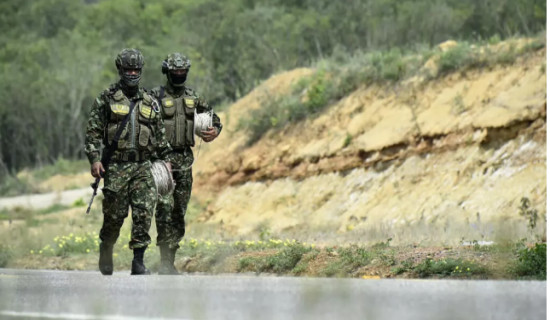- Saturday, 20 December 2025
Reckless Construction Fuels Disasters
Nepal, a land holding the most beautiful ecosystems, lies near the junction of the Indian and Eurasian plates, whose tectonic activity is the sole reason for its dramatic geology, including the formation of the Himalayas and frequent seismic activity. The condition of mountains, hills, and plains in such a small piece of land is one of the most unique conditions in the world. Nepalis have relied on this natural bounty for generations but have also faced the wrath of pervasive geological fragility. But can we dish all of the blame to our mother nature and claim that the losses are inevitable, or are we not making the right choices, which lead innocent Nepalese towards the same fate every year?
Around seven-tenths of the land hosts hills and mountains with steep, unstable slopes that experience thousands of landslides annually – most triggered by monsoon rains. While minor slope failures are frequent, around 300-500 landslides sever critical roads and devastate settlements each monsoon, according to the Nepal Disaster Report 2024 (NDRRMA). The socio-economic losses have become a grim routine, with fresh incidents of roadblocks, vehicular accidents, and ruin of settlements reported relentlessly this year (Jun-Sept). A seasonal outlook offered by the Department of Hydrology and Meteorology (DHM) predicts above-average rainfall in the upcoming monsoon. This suggests that Nepal could be on the path to another year of havoc, potentially even more severe than previous years.
A landslide is a geological phenomenon involving the downward movement of large quantities of rock, silt, clay, and sand in any proportions and combinations. The movement of materials may be very slow, from millimetres to a few centimetres per year, which is called creep. The movement may also be a sudden flow where the materials move alarmingly.
During monsoons, heavy rainfall saturates soils and increases the pore water pressure between the soil particles. It decreases the shear strength of soils, which is responsible for holding the soil intact. The slopes with already weakened geology, fractures, joints, cracks, and weathering allow water to infiltrate inside during rainfall, lessening the strength and causing instability. Besides these reasons, deforestation, unsustainable agricultural practices on slopes, poorly planned highways; excavating slopes without proper assessment, haphazard blasting while mining and quarrying, and unplanned settlements in landslide-prone zones also aid in setting up potential landslide-related disasters and are triggered when it rains.
Nepal has experienced several devastating monsoon-triggered landslides in recent years, highlighting the country's vulnerability to extreme weather and geophysical hazards. One of the most catastrophic events was the 2014 Jure landslide in Sindhupalchok District, caused by a 72-hour monsoon downpour of 450 mm. This massive landslide resulted in 156 fatalities, buried 129 homes, and blocked the Sunkoshi River for 12 hours, raising fears of a catastrophic outburst flood. For weeks, it also severed the vital Araniko Highway, a key Nepal-China trade route. In 2015, the Ghyangphedi landslide in Nuwakot District was triggered by post-monsoon rainfall of 150 mm per day on slopes already weakened by the Gorkha earthquake. It killed 72 people and wiped out four entire villages, temporarily damming tributaries of the Trishuli River. The 2020 Lidi landslide, again in Sindhupalchok, was caused by an intense 24-hour monsoon rainfall of about 220 mm on August 14. It claimed 39 lives and destroyed many homes in Lidi village. A year later, on June 15, 2021, Melamchi faced destructive mudflows triggered by intense rainfall, leading to landslides and debris flows that damaged or destroyed 337 houses and displaced around 525 families. The flood also buried the headworks of the Melamchi Water Supply Project, causing significant delays in its completion. These events underscore the urgent need for improved early warning systems, multihazard risk assessments, and resilient infrastructure development in Nepal's mountainous regions.
While we blame the events of torrential downpours as the cause of devastation, the truth is far uglier: poor engineering, reckless construction, and ignored geology turn even moderate rainfalls into deadly disasters. Nepal's cut slopes and highways are so vulnerable that even a rainfall of less than 50mm daily triggers landslides. While geological factors (weak rock/soil types, steep terrain, discontinuities, faults, and fractures) and pre-saturated soils play a role, human-made negligence is why even moderate rainfall triggers landslides in Nepal.
In several instances, essential but straightforward engineering changes and attention to detail could have prevented the loss of valuable life and property. We can talk about the Prithvi Highway (Naubise-Muglin section), where multiple landslides on sections like Kurintar and Dhungre Khola block traffic for days due to unreinforced cuts during road widening and blocking of drainage by the debris dumped during construction. Similar faults have been observed in the BP highway (Bardibas-Sindhuli) sections. Likewise, landslides on the Araniko Highway (Kathmandu–Kodari section) near Lamosangu and Bahrabise – which caused fatalities – could have been mitigated through slope stabilisation measures such as gabions, retaining walls, drainage control, bioengineering, and controlled blasting during expansion. Correspondingly, Kathmandu-Terai Fast Track's repeated minor slips during moderate rainfall stem from steep, saturated slopes. These issues can be resolved with simple measures like proper drainage facilities, the introduction of geotextile reinforcements, and terracing.
Due to engineering negligence and institutional apathy, preventable landslides claim lives and destroy property yearly. The Department of Roads under the Ministry of Physical Infrastructures must enforce strict standards when approving road designs. Contractors and construction companies often cut costs by skipping essential steps like proper geotechnical survey, slope stabilisation, and abidance to slope safety codes. The Ministry of Finance and National Planning Commission must allocate a sufficient budget for preventive engineering measures (geotechnical investigations, land-use planning, slope stabilisation, early warning systems), which are far more economical than reactive fixes (search and rescue, clearance and restoration, disaster relief, post-disaster assessment, policy reforms). Additionally, labourers should be trained in proper construction waste management. Every entity – whether a system, institution, team, or individual involved in constructing these facilities – must uphold the highest standards to prevent further tragedies.
The yearly recurrence of landslide tragedies in Nepal is a fierce reminder that proactive investments are necessary. We cannot afford to wait until devastation strikes before reacting, especially when such responses are often inadequate and rushed. Compliance with engineering standards, ethical accountability, and scrupulous attention to detail from every system, institution, team, or individual involved in infrastructure and land use planning is needed. Without this, the cycle of laxity will only sustain more tragedies, more loss of lives, and deeper socio-economic scars.
(The author is pursuing civil engineering at Pulchowk Campus)
















